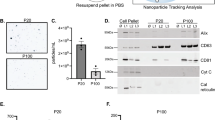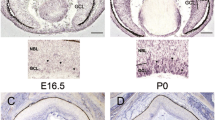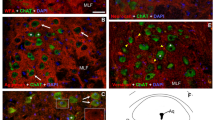Abstract
Neurones depend on contact with their target tissues for survival and subsequent development1–4. The protein, nerve growth factor (NGF), can be selectively taken up by sympathetic nerve terminals and reaches the neuronal perikaryon by a process of retrograde intra-axonal transport5, suggesting that its role in vivo is to act as a target tissue-derived trophic factor6. The development of the neurones of the chick ciliary ganglion requires the presence of structures derived from the optic cup4. Several studies in vitro have shown that media conditioned by non-neuronal cells contain factors that result in the survival of neurones from ciliary ganglia7–11. In particular, chick embryo iris, ciliary body and choroid contained large amounts of these factors indicating the presence of a target tissue-derived trophic factor for the cholinergic ciliary ganglion12. This study demonstrates that neurones of the ciliary ganglion accumulate, by retrograde intra-axonal transport, proteins synthesized and released by optic tissues in culture.
This is a preview of subscription content, access via your institution
Access options
Subscribe to this journal
Receive 51 print issues and online access
$199.00 per year
only $3.90 per issue
Buy this article
- Purchase on Springer Link
- Instant access to full article PDF
Prices may be subject to local taxes which are calculated during checkout
Similar content being viewed by others
References
Hamburger, V. & Levi-Montalcini, R. J. exp. Zool 111, 457–501 (1949).
Prestige, M. C. in The Neurosciences: Second Study Program (eds Schmitt, F. O. & Worden, F. G.) 73–82 (Rockefeller University Press, New York, 1970).
Hamburger, V. Neuroscl Res. Prog. Bull. 15, Suppl. April 1–37 (1977).
Landmesser, L. & Pilar, G. Fedn Proc. 37, 2016–2022 (1978).
Hendry, I. A., Stöckel, K., Thoenen, H. & Iversen, L. L. Brain Res. 68, 103–131 (1974).
Hendry, I. A. Rev. Neurosci. 2, 149–194 (1976).
Helfand, S. L., Smith, G. A. & Wessells, N. K. Devl Biol. 50, 541–547 (1976).
Nishi, R. & Berg, D. K. Proc. natn. Acad. Sci. U.S.A. 74, 5171–5175 (1977).
Nishi, R. & Berg, D. K. Nature 277, 232–234 (1974).
McLennan, I. S. & Hendry, I. A. Neurosci. Lett. 10, 264–273 (1978).
Varon, S., Manthorpe, M. & Adler, R. Brain Res. 173, 29–45 (1979).
Adler, R., Landa, K. B., Manthorpe, M. & Varon, S. Science 204, 1434–1436 (1979).
Bonyhady, R., Hendry, I. A., Hill, C. E. & McLennan, I. S. Neurosci. Lett. 18, 197–201 (1980).
Author information
Authors and Affiliations
Rights and permissions
About this article
Cite this article
Hendry, I., Hill, C. Retrograde axonal transport of target tissue-derived macromolecules. Nature 287, 647–649 (1980). https://doi.org/10.1038/287647a0
Received:
Accepted:
Issue Date:
DOI: https://doi.org/10.1038/287647a0
This article is cited by
-
Age-related changes in the morphology of preganglionic neurons projecting to the rat hypogastric ganglion
Journal of Neurocytology (1996)
-
Signal transduction from membrane to nucleus: The special case for neurons
Neurochemical Research (1996)
-
Nerve growth factor enhances the dendritic arborization of sympathetic ganglion cells undergoing atrophy in aged rats
Journal of Neurocytology (1994)
-
A ciliary neuronotrophic factor from peripheral nerve and smooth muscle which is not retrogradely transported
Neurochemical Research (1991)
Comments
By submitting a comment you agree to abide by our Terms and Community Guidelines. If you find something abusive or that does not comply with our terms or guidelines please flag it as inappropriate.



